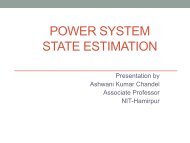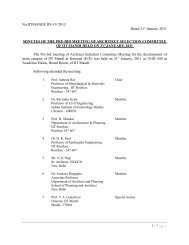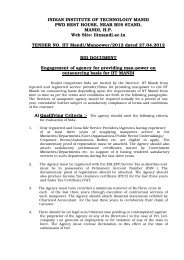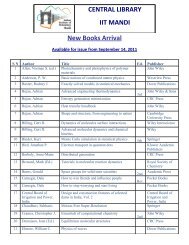Power System Security Analysis With Renewable Energy ... - IIT Mandi
Power System Security Analysis With Renewable Energy ... - IIT Mandi
Power System Security Analysis With Renewable Energy ... - IIT Mandi
You also want an ePaper? Increase the reach of your titles
YUMPU automatically turns print PDFs into web optimized ePapers that Google loves.
<strong>Power</strong> <strong>System</strong> <strong>Security</strong> <strong>Analysis</strong> <strong>With</strong><br />
<strong>Renewable</strong> <strong>Energy</strong> <strong>System</strong>s<br />
Trapti Jain<br />
School of Computing and Electrical Engineering<br />
Indian Institute of Technology <strong>Mandi</strong>
Outline<br />
• <strong>Power</strong> <strong>System</strong> <strong>Security</strong><br />
• <strong>Security</strong> in Restructured <strong>Power</strong> <strong>System</strong><br />
• Review of Load Flow <strong>Analysis</strong><br />
• Load Flow <strong>Analysis</strong> with Wind Farm<br />
• Load Flow <strong>Analysis</strong> with Photovoltaic <strong>System</strong>
<strong>Power</strong> <strong>System</strong> <strong>Security</strong><br />
•It is the ability of the system to withstand credible<br />
contingencies without violating the normal operating<br />
limits.<br />
• Classified as<br />
Static security<br />
static security evaluation detects any potential<br />
overload of a system branch or an out of limit voltage following a<br />
given list of contingencies<br />
Transient security<br />
transient security evaluation pertains to system<br />
dynamic behaviour in terms of rotor angle stability when<br />
subjected to perturbations
<strong>Security</strong> <strong>Analysis</strong><br />
Outages of component(s)<br />
Overstress on the other<br />
components<br />
No limit violation<br />
limit violation(s)<br />
operation of protective<br />
devices and switching of the<br />
unit(s)<br />
partial or total loss of<br />
load
Functions of <strong>System</strong> <strong>Security</strong><br />
<strong>System</strong><br />
Monitoring<br />
<strong>System</strong><br />
<strong>Security</strong><br />
Contingency<br />
<strong>Analysis</strong><br />
<strong>Security</strong><br />
Constrained<br />
OPF
Contingency <strong>Analysis</strong> Procedure<br />
START<br />
SET SYSTEM MODEL TO<br />
INITIAL CONDITIONS<br />
SIMULATE AN OUTAGE OF A<br />
GENERATOR OR A BRANCH<br />
SELECT A<br />
NEW OUTAGE<br />
LIMIT VIOLATION<br />
Y<br />
ALARM MESSAGE<br />
N<br />
N<br />
LAST OUTAGE<br />
END<br />
Y
Real-time applications require fast and reliable computation methods due to the high<br />
number of possible outages in a moderate power system.<br />
However, there is a well-known conflict between the accuracy of the method applied<br />
and the calculation speed.<br />
Exact solution<br />
Full AC power flow<br />
for each outage<br />
Check the limit<br />
violations<br />
not feasible<br />
for realtime<br />
applications<br />
.<br />
approximate methods to quickly<br />
identify conceivable<br />
contingencies<br />
real-time applications<br />
AC power flows only for<br />
critical contingencies.<br />
Check the limit violations
APPROXIMATE CONTINGENCY ANALYSIS<br />
Contingency ranking<br />
• contingencies are ranked in an approximate order<br />
of a scalar performance index, PI.<br />
• contingencies are tested beginning with the most<br />
severe one and proceeding down to the less<br />
severe ones up to a threshold value.<br />
• Masking effect causes false orderings and<br />
misclassifications.<br />
Contingency screening<br />
• Explicit contingency screening is performed for all<br />
contingencies, following an approximate solution<br />
(DC load flow, one iteration load flow, linear<br />
distribution or sensitivity factors etc.)<br />
• Contingency screening is performed in the near<br />
vicinity of the outages (local solutions)<br />
Hybrid methods utilizing both the ranking and the screening
<strong>Security</strong> in Restructured <strong>Power</strong> <strong>System</strong>s<br />
•In deregulated environment, <strong>System</strong> Operator (SO) is<br />
responsible for secure operation of the power system.<br />
•Available Transfer Capability is a term defined to<br />
reflect additional secure power transfer in the electricity<br />
market environment.<br />
•Congestion management is one of the major task<br />
performed by SO to ensure system security.
Available Transfer Capability (ATC) Definition *<br />
“ATC is a measure of the transfer capability remaining in the<br />
physical transmission network for further commercial activity over<br />
and above already committed use”.<br />
Mathematically,<br />
ATC = TTC – TRM – {ETC + CBM}<br />
ETC: Existing Transfer Commitment<br />
TTC: maximum amount of power which can be transferred over the<br />
network while satisfying all security constraints.<br />
TRM: margin required for uncertainties in the transmission system<br />
conditions<br />
CBM: margin reserved by load serving entities for generation<br />
reliability requirements.<br />
*<br />
North American Electric Reliability Council (NERC), Available Transfer Capability Definitions and<br />
Determination, NERC Report, June 1996.
ATC and Related Terms (NERC Report)<br />
TRM – Transfer Reliability Margin<br />
CBM – Capacity Benefit Margin<br />
ATC – Available Transfer Capability<br />
TTC – Total Transfer Capability<br />
ETC - Existing Transfer Commitments<br />
Usually, the TRM and CBM are decided by the utilities according to their<br />
specific system condition and reliability requirements. Thus, the ATC can<br />
be defined as,<br />
ATC = TTC – ETC
ATC Determination<br />
1. Static ATC Methods<br />
• Line flow limits<br />
• Bus voltage limits<br />
•Generator real and reactive power<br />
limits<br />
• Static voltage stability limit<br />
• Repetitive power flow based methods<br />
•Continuation power flow based<br />
methods<br />
• Sensitivity based methods<br />
•Optimal power flow based methods<br />
2. Dynamic ATC Methods<br />
• Line flow limits<br />
• Bus voltage limits<br />
•Generator real and reactive power<br />
limits<br />
• Small signal stability limit<br />
• Large signal stability limit<br />
• Trajectory sensitivity based<br />
methods<br />
• <strong>Energy</strong> function based methods<br />
• Optimal power flow based<br />
methods<br />
• Single Machine Equivalent<br />
(SIME)
Methods of Congestion Management<br />
• Price Area based Congestion Management<br />
- areas with excess generation will have lower prices,<br />
and those with excess load will have higher prices<br />
• ATC based Congestion Management<br />
- use ATC information available there to determine if<br />
system could accommodate transaction.<br />
• OPF based Congestion Management<br />
- optimal power flow (OPF) is performed to minimize<br />
generators’ operating cost subject to set of constraints that<br />
represent a model of the transmission system within which the<br />
generator operate
Objective of Load Flow <strong>Analysis</strong><br />
•To determine the static operating state of the<br />
power system for given loads<br />
•To determine voltage magnitude and angle at<br />
all the buses<br />
•To determine line flows and system losses
Classification of load flow methods<br />
• Deterministic Load Flow (DLF)<br />
- a set of deterministic values are chosen by<br />
the analyst for each input variable<br />
- accuracy depends on the knowledge of the<br />
input data<br />
- ignores grid uncertainty<br />
• Probabilistic Load Flow (PLF)<br />
- utilizes different mathematical approaches<br />
such as probabilistic approach, fuzzy sets, interval<br />
analysis etc. for taking into account uncertainty<br />
- requires inputs with PDF or CDF
DLF with Conventional Generators<br />
Main steps to perform load flow analysis<br />
• Develop the mathematical model of various elements<br />
•Write the network equations relating current and<br />
voltages<br />
•Identify the nature of equations and apply suitable<br />
solution technique
Mathematical Model of Various Elements<br />
• Transmission line - nominal equivalent π model is used<br />
• Transformers - equivalent π model is used<br />
⎧A<br />
=<br />
⎪<br />
⎨B<br />
=<br />
⎪<br />
⎩C<br />
=<br />
y<br />
12<br />
/ a<br />
(1/ a −1)<br />
⋅ y<br />
(1 −1/<br />
a).<br />
y<br />
12<br />
12<br />
/ a<br />
• Loads - constant power model<br />
• Generators - real and reactive power output l
Bus Admittance Matrix or Y bus<br />
• First step in solving the power flow is to create the bus<br />
admittance matrix, often called the Y bus<br />
.<br />
• The Y bus<br />
gives the relationships between all the bus<br />
current injections, I, and all the bus voltages, V,<br />
I = Y bus<br />
V<br />
• The Y bus<br />
is developed by applying KCL at each bus in the<br />
system to relate the bus current injections, the bus<br />
voltages, and the branch impedances and admittances.<br />
• The diagonal elements are the self admittance terms,<br />
equal to the algebraic sum of all the primitive value of<br />
admittances incident at the node or bus.<br />
• The off-diagonal terms are equal to the negative of the<br />
admittance connected between the two buses.
Load Flow Equations<br />
Applying KCL at each bus-i, in an n-bus system, the<br />
current injection I i<br />
, is given by<br />
I<br />
i<br />
=<br />
I<br />
ij<br />
+<br />
I<br />
ik<br />
+ ....... I<br />
in<br />
=<br />
n<br />
∑<br />
v=<br />
1<br />
I<br />
iv<br />
Since I=Y bus<br />
V, we also know<br />
I<br />
i<br />
=<br />
n<br />
∑<br />
j=<br />
1<br />
The net complex power injected into a bus-i is given by<br />
*<br />
S = P + jQ = V I<br />
i<br />
i<br />
i<br />
Taking complex conjugate of above equation,<br />
*<br />
P − jQ = V I<br />
i<br />
i<br />
Y<br />
ij<br />
V<br />
i<br />
i<br />
j<br />
i<br />
i
Load Flow Equations, Contd.<br />
*<br />
( Pi<br />
− jQi<br />
) = ( PGi<br />
− PDi<br />
) − j( QGi<br />
−QDi<br />
) = Vi<br />
YijV<br />
j<br />
In polar form,<br />
( P − jQ ) = ( P − P ) − j( Q − Q )<br />
=<br />
i<br />
n<br />
∑<br />
j=<br />
1<br />
VV Y<br />
i<br />
i<br />
j<br />
ij<br />
Gi<br />
V Y V<br />
Separating into real and imaginary parts<br />
n<br />
∑<br />
j=<br />
1<br />
[ cos( δ −δ<br />
−θ<br />
) − j sin( δ −δ<br />
−θ<br />
)] i = 1,2,.... n<br />
i<br />
Di<br />
j<br />
ij<br />
Gi<br />
Di<br />
=<br />
i<br />
n<br />
∑<br />
j=<br />
1<br />
j<br />
i<br />
ij<br />
ij<br />
j<br />
∠δ<br />
−δ<br />
i<br />
j<br />
−θ<br />
ij<br />
P<br />
i<br />
=<br />
P<br />
Gi<br />
−<br />
P<br />
Di<br />
=<br />
n<br />
∑<br />
j=<br />
1<br />
VV Y<br />
i<br />
j<br />
ij<br />
cos( δ − δ<br />
i<br />
j<br />
−θ<br />
ij<br />
)<br />
i<br />
= 1,2,..... n<br />
Q<br />
i<br />
=<br />
Q<br />
Gi<br />
− Q<br />
Di<br />
=<br />
n<br />
∑<br />
j=<br />
1<br />
VV Y<br />
i<br />
j<br />
ij<br />
sin( δ<br />
i<br />
− δ<br />
j<br />
−θ<br />
ij<br />
)<br />
i<br />
= 1,2,..... n
Classification of Buses<br />
PQ bus PV bus Slack<br />
bus<br />
- Load bus<br />
- Buses to which only<br />
loads are connected<br />
- Real and reactive<br />
powers are specified<br />
- Load flow solution<br />
determines voltage<br />
magnitude and angle<br />
- Generator bus or voltage<br />
controlled bus<br />
- Buses to which generators<br />
or reactive power sources<br />
are connected<br />
- Real power and voltage<br />
magnitude are specified<br />
- Load flow solution<br />
determines reactive power<br />
and angle<br />
- Reference bus or<br />
swing bus<br />
- A generator bus<br />
having largest output<br />
- Real and reactive<br />
powers are specified<br />
- Load flow solution<br />
determines voltage<br />
magnitude and angle
Numerical Solution Techniques<br />
• Gauss Iterative and Gauss-Siedel methods<br />
• Newton-Raphson method<br />
- Rectangular coordinates<br />
- Polar coordinates<br />
• Fast Decoupled Load Flow method
NRLF method in Polar coordinates<br />
The power flow equations in polar coordinates can be<br />
written as,<br />
P<br />
i<br />
Q<br />
i<br />
=<br />
=<br />
n<br />
∑<br />
j=<br />
1<br />
n<br />
∑<br />
j=<br />
1<br />
VV<br />
i<br />
VV<br />
i<br />
j<br />
( G cosδ<br />
+ B sinδ<br />
)<br />
j<br />
ij<br />
i = 2,..... n<br />
( G sinδ<br />
−B<br />
cosδ<br />
) i = m + 1,..... n<br />
ij<br />
ij<br />
ij<br />
ij<br />
ij<br />
ij<br />
ij<br />
where,<br />
δ<br />
ij<br />
=<br />
δ<br />
i<br />
− δ<br />
j<br />
The correction vector can be written as<br />
∆V<br />
∆δ<br />
n<br />
<br />
∆δ<br />
n<br />
∆V<br />
/ V<br />
<br />
2<br />
m+<br />
1<br />
/ V<br />
n<br />
∂P<br />
∂P<br />
H = L = V<br />
= ∂δ<br />
∂V<br />
∂Q<br />
∂Q<br />
M = N = V<br />
∂δ<br />
∂V<br />
∆P<br />
<br />
∆P<br />
∆Q<br />
n<br />
∆Q<br />
m+<br />
1<br />
<br />
2<br />
n
Computational steps to solve load flow problem<br />
Step 1: Read network admittances, generator, load and<br />
transformer data<br />
Step 2: Form Y bus<br />
matrix<br />
Step 3: Assume initial values of bus voltages except at<br />
slack bus. Initialize iteration count K to zero.<br />
Step 4: Compute P at all buses except slack bus and Q<br />
at all the load buses. Calculate ∆P at all buses<br />
except slack bus, ∆Q at all the load buses.<br />
Step 5: If all the elements of mismatch vectors (∆P, ∆Q)<br />
are within the prespecified tolerance, load flow<br />
solution is achieved. Calculate slack bus power,
Contd.<br />
Step 6: Assemble Jacobian matrix, find its inverse and<br />
calculate correction vector<br />
Step 7: Update angles at all the buses except slack bus<br />
and voltages at all the load buses and go to<br />
step 4<br />
The reactive power limits of generators can be<br />
checked at step 4. If the calculated reactive<br />
power of any PV bus is within the limit, it is<br />
retained as PV bus. If it violates the limit, the<br />
generator output is fixed to the limiting value<br />
and the bus is solved as PQ type for that<br />
particular iteration, with specified value of Q<br />
taken as difference between the limiting value<br />
and the calculated value.
Steady State Model of Wind Farm<br />
• As a negative load (PQ bus)<br />
- assumes a generated real power and a given power factor,<br />
with which the consumed reactive power is calculated.<br />
• As a voltage controlled (PV bus)<br />
- when the voltage at the connection point need to be<br />
controlled at normal voltage by providing reactive power support<br />
• PX bus model<br />
- the real power is known and the reactive power is calculated<br />
as a function of the magnetizing reactance of the generator<br />
• RX bus model<br />
- assumes resistance and reactance of both stator and rotor<br />
as well as the mechanical output power P m<br />
to be known variables
Steady State Model of Wind Farm, Contd.<br />
An improved PQ bus model has been proposed considering the<br />
steady state properties of the induction generator, such that the<br />
reactive power Q is calculated by<br />
Q<br />
≈V<br />
2<br />
⎛<br />
⎜<br />
⎝<br />
X − X<br />
X X<br />
c m<br />
+<br />
c<br />
where, X c<br />
is capacitive reactance<br />
X m<br />
is magnetizing reactance<br />
X is sum of stator and rotor reactances<br />
V is terminal voltage<br />
P is real power of the generator<br />
The improved PQ bus model requires that the specified<br />
reactive power Q be updated after each iteration of the load<br />
flow<br />
m<br />
⎞<br />
⎟ ⎠<br />
X<br />
V<br />
*<br />
A.E. Feijoo and J. Cidras, “Modeling of Wind Farms in the Load Flow <strong>Analysis</strong>”,<br />
IEEE Transactions on <strong>Power</strong> <strong>System</strong>, Vol. 15, No. 1, Feb. 2000, pp. 110-115<br />
2<br />
P<br />
2
PX bus model<br />
• Constant reactance model<br />
- assumes a constant active power generation and a<br />
constant magnetizing reactance, neglecting the stator and<br />
rotor reactances<br />
- constant relation between the voltage level and the<br />
reactive power consumption<br />
• Variable reactance model<br />
- considers saturation of magnetic circuit<br />
- models magnetizing reactance as voltage<br />
dependent
R<br />
( s)<br />
=<br />
Let R(<br />
s)<br />
P<br />
eq<br />
IG<br />
( V , s)<br />
2<br />
r<br />
R<br />
s<br />
+ ( X<br />
= R + R<br />
=<br />
R<br />
s<br />
2<br />
R<br />
r<br />
X<br />
s<br />
m<br />
V<br />
eq<br />
( s)<br />
+<br />
2<br />
m<br />
2<br />
+<br />
( s)<br />
X<br />
X<br />
2<br />
r<br />
)<br />
( s)<br />
2<br />
and<br />
;<br />
X<br />
R(<br />
s)<br />
eq<br />
( s)<br />
=<br />
X ( s)<br />
=<br />
;<br />
Q<br />
X<br />
IG<br />
R<br />
s<br />
r<br />
+<br />
X<br />
s<br />
2<br />
m<br />
2<br />
r<br />
R<br />
s<br />
X<br />
eq<br />
+<br />
( V , s)<br />
=<br />
X<br />
( s)<br />
R<br />
m<br />
+ ( X<br />
2<br />
X<br />
m<br />
r<br />
V<br />
( s)<br />
+<br />
( X<br />
+<br />
2<br />
X<br />
X<br />
m<br />
r<br />
2<br />
)<br />
+<br />
2<br />
( s)<br />
X<br />
r<br />
)<br />
X ( s)<br />
*<br />
N. paensuwan and A. Yokoyama, “Risk-based TTC calculation of a power system<br />
with renewable energy resources”, IEEE <strong>Power</strong> Tech Conference, 2009
Contd.<br />
This PX model introduces a new state variable i.e. the rotor<br />
slip. Therefore, another equation is required to enforce P IG<br />
to its specified value. The power balance equations are<br />
modified as follows.<br />
f<br />
f<br />
Pi<br />
Qi<br />
=<br />
=<br />
( δ , V ) − ( P<br />
( δ , V ) − ( −Q<br />
) = 0<br />
To enforce P IGi<br />
to its specified value, the following equation<br />
is added.<br />
spec<br />
f P IGi<br />
− P<br />
− Q<br />
The augmented power flow problem is<br />
⎡ ∂f<br />
P<br />
⎢<br />
∂δ<br />
⎢<br />
∂f<br />
⎢ Q<br />
⎢ ∂δ<br />
⎢ ∂f<br />
PIG<br />
⎢<br />
⎣ ∂δ<br />
F<br />
F<br />
Pi<br />
Qi<br />
spec<br />
IGi<br />
Di<br />
Di<br />
IGi<br />
( V<br />
( V , s ) = −P<br />
( V , s ) − P = 0<br />
i<br />
∂f<br />
i<br />
∂V<br />
∂f<br />
Q<br />
∂V<br />
∂f<br />
P<br />
P<br />
IG<br />
∂V<br />
∂f<br />
IGi<br />
∂s<br />
∂f<br />
Q<br />
∂s<br />
∂f<br />
P<br />
P<br />
IG<br />
∂s<br />
i<br />
i<br />
IGi<br />
⎤<br />
⎥<br />
⎥⎡∆δ<br />
⎤ ⎡ ∆f<br />
⎥⎢<br />
⎥ ⎢<br />
⎢<br />
∆V<br />
⎥<br />
= ⎢ ∆f<br />
⎥<br />
⎥⎢<br />
⎥ ⎢<br />
⎣ ∆s<br />
⎦ ⎣<br />
∆f<br />
⎥<br />
⎦<br />
Q<br />
P<br />
P<br />
IG<br />
⎤<br />
⎥ ⎥⎥ ⎦<br />
i<br />
, s<br />
i<br />
)) = 0
RX bus model<br />
Equivalent circuit of induction generator<br />
Voltage obtained from each iteration of load flow is used to calculate the slip<br />
2 (1 −s)<br />
P m<br />
= R2<br />
⋅ I<br />
2<br />
⋅<br />
s<br />
where,<br />
I<br />
2<br />
=<br />
−<br />
Vt<br />
[( R1<br />
+ R2<br />
/ s)<br />
+ j(<br />
X1<br />
+ X<br />
2)]<br />
Once, the slip is known, power injections can be calculated<br />
P<br />
g<br />
Q<br />
g<br />
= −V<br />
t<br />
= −V<br />
t<br />
2<br />
2<br />
⋅<br />
( R<br />
1<br />
( R<br />
⋅<br />
1<br />
( R1<br />
+ R2<br />
/ s)<br />
+ R<br />
2<br />
/ s)<br />
+ ( X + X<br />
2<br />
+ R<br />
X<br />
2<br />
m<br />
/ s)<br />
⋅<br />
2<br />
1 2 m 1<br />
2<br />
2<br />
((<br />
R + R / s)<br />
+ ( X + X ) )<br />
1<br />
1<br />
+ ( X<br />
2<br />
+ X<br />
2<br />
)<br />
2<br />
) ⋅(<br />
X<br />
1<br />
+ X<br />
2<br />
+ X<br />
2<br />
)
Solution Techniques of PLF<br />
Numerical Method<br />
•DLF is performed a large<br />
number of times with inputs of<br />
different combinations of nodal<br />
power values<br />
•exact non-linear form of load<br />
flow equations can be used<br />
•Monte Carlo simulation is<br />
used<br />
•time consuming<br />
Analytical Method<br />
•analyzes a system and its<br />
inputs using mathematical<br />
expressions<br />
•uses linearized load flow<br />
equations<br />
•complicated mathematical<br />
computation<br />
•inaccurate due to different<br />
approximations
Probabilistic Model of Wind Farms<br />
• Probabilistic model of the wind speed<br />
Weibull distribution is the best pdf for the description<br />
of a wind speed<br />
1<br />
k ⎛ v − v ⎡<br />
0 ⎞ ⎛ v − v0<br />
f ( v)<br />
= ⎜ ⎟ exp ⎢−<br />
⎜<br />
c ⎝ c ⎠ ⎢⎣<br />
⎝ c<br />
k − k<br />
where, v is wind speed<br />
v 0<br />
is cut-out speed<br />
k is shape parameter<br />
c is scale parameter<br />
⎞<br />
⎟<br />
⎠<br />
⎤<br />
⎥<br />
⎥⎦<br />
*<br />
L. Dong, W. Cheng, H. Bao and Y. Yang, “Probabilistic Load Flow analysis for<br />
power system containing wind farms”, IEEE 2010
Probabilistic Model of Wind Farms, Contd.<br />
• Probabilistic model of wind turbine<br />
P<br />
w<br />
⎧0<br />
⎪<br />
k1v<br />
+<br />
= ⎨<br />
⎪ Pr<br />
⎪<br />
⎩0<br />
P<br />
k<br />
2<br />
v ≤<br />
v<br />
r<br />
vci<br />
≤ v ≤<br />
vr<br />
≤ v ≤<br />
v > v<br />
co<br />
r<br />
k1 = ; k2<br />
= −k1<br />
vr<br />
−vci<br />
v<br />
v<br />
v<br />
ci<br />
r<br />
co<br />
P<br />
P r<br />
0 v ci<br />
v r<br />
v co<br />
Wind Turbine power output<br />
curve curve<br />
v<br />
where, P r<br />
is rated output power<br />
v r<br />
is rated wind speed<br />
v ci<br />
is cut-in speed<br />
v co<br />
is cut-out speed
Probabilistic Model of Wind Farms, Contd.<br />
•Probabilistic distribution of the active power generated by<br />
WT<br />
F(<br />
P<br />
w<br />
w<br />
)<br />
f ( P )<br />
=<br />
=<br />
v<br />
v<br />
ci<br />
∫<br />
co<br />
F<br />
'<br />
f ( v)<br />
dv +<br />
( P<br />
w<br />
)<br />
=<br />
Pw<br />
−k<br />
k<br />
∫<br />
v<br />
1<br />
ci<br />
2<br />
k ⎛ P<br />
⎜<br />
k1c<br />
⎝<br />
f ( v)<br />
dv<br />
w<br />
−<br />
k1v<br />
k c<br />
1<br />
co<br />
⋅ exp<br />
•Probabilistic distribution of the reactive power absorbed<br />
by WT<br />
−<br />
k<br />
2<br />
⎞<br />
⎟<br />
⎠<br />
k −1<br />
⎡ ⎛ P<br />
⎢−<br />
⎜<br />
⎢⎣<br />
⎝<br />
w<br />
−<br />
k1v<br />
k c<br />
1<br />
co<br />
−<br />
k<br />
2<br />
⎞<br />
⎟<br />
⎠<br />
k<br />
⎤<br />
⎥<br />
⎥⎦<br />
f ( Q ) = tan θ<br />
w<br />
w<br />
⋅<br />
k<br />
k c<br />
1<br />
⎛<br />
⎜<br />
⎝<br />
P<br />
w<br />
−<br />
k1v<br />
k c<br />
1<br />
co<br />
−<br />
k<br />
2<br />
⎞<br />
⎟<br />
⎠<br />
k −1<br />
⋅exp<br />
⎡ ⎛<br />
⎢−<br />
⎜<br />
⎢⎣<br />
⎝<br />
P<br />
w<br />
−<br />
k1v<br />
k c<br />
1<br />
co<br />
−<br />
k<br />
2<br />
⎞<br />
⎟<br />
⎠<br />
k<br />
⎤<br />
⎥<br />
⎥⎦
AC Probabilistic Load Flow Model<br />
Linearized Load Flow Model<br />
⎧ w = f ( x)<br />
⎨<br />
⎩ z = g(<br />
x)<br />
;<br />
⎪<br />
⎧ ∆x<br />
= J<br />
⎨<br />
⎪⎩ ∆z<br />
= G<br />
−1<br />
0<br />
⋅ ∆w<br />
= S<br />
Step 1: Input the system data and wind farm data<br />
Step 2: Run the DLF using NR method, so that the<br />
expected values of nodal voltages,line flows,<br />
S 0<br />
, and T 0<br />
are obtained.<br />
Step 3: Compute the cumulants of generation and load<br />
according to their probabilistic distribution<br />
Step 4: Compute the cumulants of the generated active<br />
⋅ ∆ w<br />
power, absorbed reactive power, power<br />
injections and state variables (∆x and ∆z)<br />
Step 5: Obtain the PDF and CDF of ∆x and ∆z<br />
0<br />
⋅ J<br />
−1<br />
0<br />
0<br />
⋅ ∆ w<br />
⋅ ∆ w = T<br />
0
Load Flow with AC-DC <strong>System</strong>s<br />
• Unified method<br />
- solution vector is extended with the dc<br />
variables<br />
- complex to program and hard to combine<br />
with developments in ac power flow solution<br />
techniques such as fast decoupled method<br />
• Sequential method<br />
- ac and dc equations are solved separately<br />
in each iteration<br />
- easy to implement, but convergence<br />
problems are there
Model of Photovoltaic <strong>System</strong>s<br />
PV<br />
P<br />
Array PV<br />
V PV<br />
I PV<br />
Inverter<br />
M, α<br />
P i<br />
, Q i<br />
V i<br />
Three<br />
phase<br />
system<br />
P g<br />
, Q g<br />
Block diagram of grid connected PV system<br />
• Model based on characteristics of PV array<br />
•Model based on characteristics of specific<br />
inverter structure<br />
• Overall PV system model<br />
Y.B. Wang, C.S. Wu, L. Hua and H.H. Xu, “Staedy-state model and power flow<br />
analysis of Grid-Connected Photovoltaic <strong>Power</strong> <strong>System</strong>”,
Model of Photovoltaic <strong>System</strong>s, Contd.<br />
• DC part model<br />
I<br />
cell<br />
=<br />
d(<br />
VI)<br />
dV<br />
I<br />
L<br />
mpp<br />
− I<br />
=<br />
=<br />
0<br />
I<br />
I<br />
= 0<br />
⎡ ⎛ Vcell<br />
+ I<br />
⎢exp⎜<br />
⎣ ⎝ a<br />
mpp<br />
mpp<br />
+ V<br />
+ V<br />
mpp<br />
mpp<br />
dI<br />
dV<br />
aR<br />
cell<br />
sh<br />
mpp<br />
R<br />
s<br />
− I<br />
+ I<br />
⎞ ⎤<br />
⎟ −1⎥ ⎠ ⎦<br />
− V<br />
0<br />
0<br />
cell<br />
+ I<br />
R<br />
sh<br />
cell<br />
R<br />
⎛ Vmpp<br />
+ ImppR<br />
Rsh<br />
exp⎜<br />
⎝ a<br />
⎛ Vmpp<br />
+ I<br />
RsRsh<br />
exp⎜<br />
⎝ a<br />
s<br />
s<br />
mpp<br />
⎞<br />
⎟ − a<br />
⎠<br />
Rs<br />
⎞<br />
⎟ + aR<br />
⎠<br />
s<br />
(1)<br />
(2)<br />
where, I cell<br />
and V cell<br />
are the current and voltage of PV cell<br />
I L<br />
and I 0<br />
are the light current and diode reverse saturation<br />
current<br />
R s<br />
and R sh<br />
are the series and shunt resistance<br />
a is the ideality factor
Model of Photovoltaic <strong>System</strong>s, Contd.<br />
V<br />
I<br />
P<br />
PV<br />
PV<br />
PV<br />
= N<br />
= N<br />
= V<br />
s<br />
pp<br />
PV<br />
N<br />
I<br />
I<br />
ss<br />
cell<br />
PV<br />
V<br />
cell<br />
(3)<br />
(1)<br />
where, I PV<br />
, V PV<br />
, and P PV<br />
are the current, voltage and power of the<br />
PV array<br />
N s<br />
is the series number of PV cell in a PV module<br />
N ss<br />
is the series number of PV modules<br />
N pp<br />
is the parallel number of PV modules<br />
• Inverter part model<br />
2<br />
V<br />
i<br />
= Vi∠α<br />
= MVPV<br />
∠α<br />
; Pi<br />
=<br />
4<br />
P<br />
PV<br />
(4) ; (5)<br />
where, M is amplitude modulation ratio<br />
α is phase shift angle
Model of Photovoltaic <strong>System</strong>s, Contd.<br />
• AC part model<br />
⎥<br />
⎦<br />
⎤<br />
⎢<br />
⎣<br />
⎡<br />
+<br />
+<br />
−<br />
−<br />
=<br />
⎥<br />
⎦<br />
⎤<br />
⎢<br />
⎣<br />
⎡<br />
−<br />
−<br />
−<br />
−<br />
=<br />
⎥<br />
⎦<br />
⎤<br />
⎢<br />
⎣<br />
⎡<br />
−<br />
−<br />
+<br />
+<br />
=<br />
⎥<br />
⎦<br />
⎤<br />
⎢<br />
⎣<br />
⎡<br />
−<br />
−<br />
−<br />
+<br />
=<br />
23<br />
23<br />
12<br />
12<br />
12<br />
12<br />
23<br />
23<br />
12<br />
12<br />
12<br />
12<br />
12<br />
12<br />
13<br />
13<br />
12<br />
12<br />
12<br />
12<br />
13<br />
13<br />
12<br />
12<br />
sin<br />
sin<br />
)<br />
sin(<br />
3<br />
cos<br />
cos<br />
)<br />
cos(<br />
3<br />
)<br />
sin(<br />
sin<br />
sin<br />
3<br />
)<br />
cos(<br />
cos<br />
cos<br />
3<br />
φ<br />
φ<br />
φ<br />
θ<br />
α<br />
φ<br />
φ<br />
φ<br />
θ<br />
α<br />
φ<br />
α<br />
θ<br />
φ<br />
φ<br />
φ<br />
α<br />
θ<br />
φ<br />
φ<br />
z<br />
V<br />
z<br />
V<br />
z<br />
V<br />
V<br />
Q<br />
z<br />
V<br />
z<br />
V<br />
z<br />
V<br />
V<br />
P<br />
z<br />
V<br />
z<br />
V<br />
z<br />
V<br />
V<br />
Q<br />
z<br />
V<br />
z<br />
V<br />
z<br />
V<br />
V<br />
P<br />
g<br />
g<br />
g<br />
i<br />
g<br />
g<br />
g<br />
g<br />
g<br />
i<br />
g<br />
g<br />
g<br />
g<br />
i<br />
i<br />
i<br />
i<br />
g<br />
g<br />
i<br />
i<br />
i<br />
i<br />
(6)<br />
(9)<br />
(8)<br />
(7)
Operation Modes of Grid-connected PV system<br />
There are nine unknown variables of model and seven<br />
independent equations (1), (4-9)<br />
• Mode 1: PV system applies MPPT strategy and unit<br />
power factor. In this mode, (2) is added and Q g<br />
is set to zero. Then V PV<br />
and P PV<br />
can be carried<br />
out by (1) to (3), and other variables can be<br />
solved by (4) to (9)<br />
• Mode 2: PV system applies MPPT strategy and exports a<br />
certain amount of reactive power. In this mode,<br />
the PV system can provide reactive power and<br />
voltage support for power grid.
Input parameters of<br />
power grid, PV system<br />
and meteorology<br />
Set V g<br />
=rated value,Q g<br />
=0, and solve<br />
PV system model to achieve<br />
M,α,V PV<br />
,P PV,<br />
V i<br />
,P i<br />
,Q i<br />
and P g<br />
PQ type<br />
Traditional power<br />
flow analysis<br />
Node type of<br />
PVPCC <br />
PV type<br />
Traditional power<br />
flow analysis<br />
Set the<br />
parameter at the<br />
limit<br />
Yes<br />
Solve PV system model<br />
to achieve M,α,V PV<br />
,P PV,<br />
V i<br />
,<br />
P i<br />
,Q i<br />
,P g<br />
and Q g<br />
If any<br />
parameter<br />
exceeds a<br />
limit No<br />
If the iteration<br />
converges <br />
No<br />
Yes<br />
Output operating<br />
parameters of PV<br />
system and power grid
Thank You
















